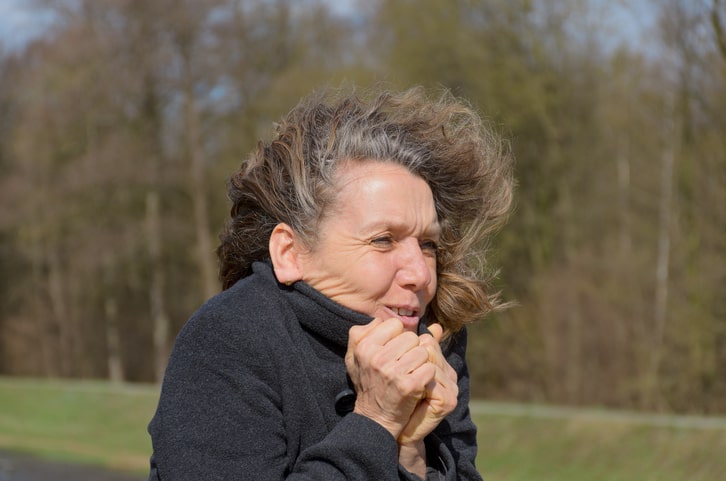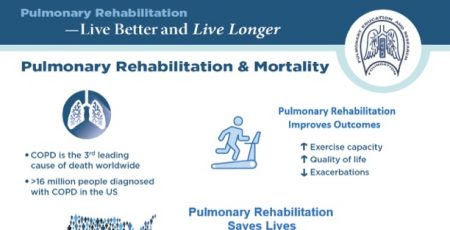
30 Sep COPD and Cold Weather
Why Are you More Likely to Trigger Lung Problems in the Winter?
by Nicholas Tiller Ph.D.
People with respiratory disorders, such as COPD and asthma, often find their symptoms are worse in cold weather. In fact, cold environmental conditions significantly increase COPD exacerbations and hospital admissions. This article explains how cold air affects the airways, and describes the steps one can take to reduce the impact of cold-air-induced respiratory distress.
How does cold air affect the body?
Cold conditions can affect physical function in two important ways.
First, the body must work harder in cold conditions to keep core temperature within the optimal range. To achieve this, blood vessels in the arms and legs narrow (constrict) thereby keeping blood and warmth near the vital organs. While this preserves the function of the internal environment, it can impact the body’s ability to increase the delivery of blood and oxygen to the working muscles during physical activity.
Second, cold air acts directly on the airways, worsening respiratory symptoms. Air moves from the atmosphere into the blood via small air sacs in the lungs called alveoli. But before reaching the alveoli, air must travel through the conducting airways (the nose, mouth, trachea, and bronchioles) which warm and humidify the air to facilitate gas transfer in the lungs. This is achieved very efficiently under normal conditions.
But in people with COPD and asthma, the airways can become “hyperresponsive”. This means that they are more reactive to certain triggers. The upper airways become progressively dehydrated as they work to humidify and warm the inhaled air. In some people, this causes an inflammatory response resulting in mucous production and airway narrowing, both of which worsen respiratory symptoms. Such hypersensitivity also explains why pollution and other allergens can trigger respiratory distress.
How can I mitigate the negative effects of cold air?
For COPD and asthma patients, there are several preventative measures to cold-air-induced respiratory distress.
- Avoid the triggers. It goes without saying that the most effective way of avoiding cold-air-induced respiratory distress is to avoid these climates to begin with. At the very least, try and avoid prolonged and/or strenuous physical activity when the conditions are cold and/or dry. This might be easy where PERF is based in Los Angeles, but considerably more difficult in other parts of the country. Keep abreast of the weather conditions and plan your outdoor excursions accordingly. High pollen counts and pollution can have a similar affect.
- Use a facemask. Wearing a facemask might have drawn attention a few years ago, but they’ve become ubiquitous in modern culture due to the ongoing COVID-19 pandemic. Even after vaccination, many individuals continue to wear facemasks to reduce COVID infection risk when navigating public spaces. But there is likely an additional benefit to wearing a facemask because they trap warm, humid air that is exhaled from the lungs. Although some COPD patients report that wearing a facemask is uncomfortable and adds to their feelings of breathlessness, for others, there is evidence that facemasks might reduce respiratory symptoms in people with airway disease. Wearing a facemask is absolutely safe during physical activity. More traditional forms of winter face wear, such as wearing a scarf high over the nose and mouth, a snood, or other forms of face-covering will have a similar effect to reduce the drying effect of cold air (but may not be as efficient at protecting against COVID-19 transmission).
- Use your inhaler. It is important that individuals with inhalers use them diligently as prescribed by their physician. The most common type of inhaler prescribed for COPD are bronchodilators which cause the airway smooth muscle to relax. This, in turn, can partially counter the effect of cold-air-induced airway constriction.
- Quit smoking. There are numerous reasons to quit smoking. Among them is that smoking is associated with airway hyperresponsiveness which will make the inherent response to cold weather much more severe. Quitting smoking may be the most important preventative in cold-air-induced respiratory distress.





Jimmy prata
Posted at 10:15h, 15 OctoberThis will be the first winter in five years that I am up north it’s only October and I already feel my body change it for the worst can’t wait to get back the Florida in January so I can feel almost human again.
PERF
Posted at 20:37h, 24 MarchDear Jimmy,
Please forgive this long delay in responding to your post. It was found buried in more than 400 spam posts!
I don’t know what you mean by “up North” but I do know all about those cold winters! I will always appreciate our weather in Southern California after growing up in Connecticut. Though I do admit to missing that first snow of the season. Don’t you?
Best wishes,
Mary Burns, RN, BS